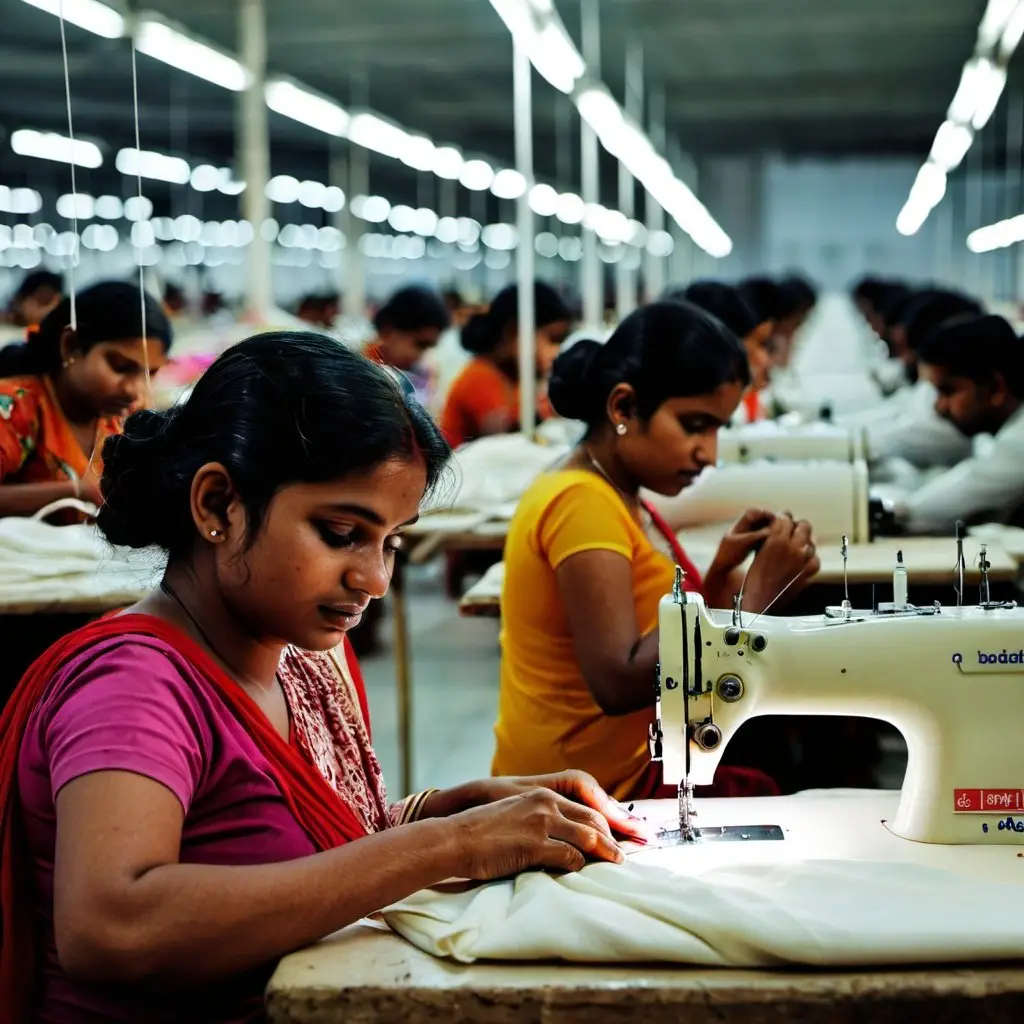The global textile and garment industry has always been highly competitive, with brands consistently seeking the best value, quality, and production efficiency. For decades, Bangladesh has been a significant player in the global apparel market, often regarded as a go-to destination for mass production due to its skilled labor, cost competitiveness, and reliable output. However, in recent years, neighboring India made substantial strides in its garment manufacturing industry, attracting many global clothing brands looking for alternatives. Despite India’s growing presence in the apparel supply chain, a notable trend has emerged: global clothing brands are now shifting their production back to Bangladesh, citing concerns about quality issues in Indian garment manufacturing.
- The Global Garment Industry: A Brief Overview
- The Role of Quality in Garment Manufacturing
- Why India Faced Quality Challenges
- Bangladesh: A Trusted Hub for Global Apparel Brands
- 1. Proven Expertise and Skilled Workforce
- 2. Established Infrastructure and Technology
- 3. Competitive Pricing
- 4. Focus on Compliance and Sustainability
- 5. Strong Supply Chain Management
- Impact on Global Clothing Brands
- The Future of Garment Manufacturing
- Conclusion
The Global Garment Industry: A Brief Overview
The garment and textile industry is a cornerstone of the global economy, with the sector valued at over $2.5 trillion. Major fashion brands rely heavily on outsourcing production to countries with strong infrastructures, cost efficiency, and skilled workforces. For decades, China, Vietnam, India, and Bangladesh have been key players in this industry. While China has dominated due to its scale and speed, Bangladesh has carved out a niche for itself in affordable, high-quality production of garments, particularly in sectors like knitwear, woven apparel, and ready-made garments (RMG).
India, a country with vast resources, technical expertise, and a burgeoning workforce, has also invested heavily in its garment sector. With government initiatives like the “Make in India” campaign, India positioned itself as a strong contender in the global market. International brands began exploring India as a destination for garment manufacturing, hoping for competitive pricing and closer proximity to their supply chains.
However, the initial optimism surrounding India’s growing garment industry has been tempered by mounting concerns over quality inconsistencies, missed delivery timelines, and a lack of experienced labor in critical segments. These shortcomings have prompted many global clothing brands to reconsider their production strategies and shift their focus back to Bangladesh.
The Role of Quality in Garment Manufacturing
In the global clothing market, quality is non-negotiable. Brands invest in rigorous quality control systems to ensure that garments meet customer expectations, maintain durability, and reflect the brand’s reputation for excellence.
Quality issues can arise in various forms:
- Fabric Quality: The base material must meet the required standards for texture, strength, and finish.
- Seam Integrity: Poor stitching or weak seams can cause garments to fail during usage.
- Color Consistency: Inconsistencies in dyeing and printing often lead to rejected batches.
- Measurements and Fit: Uniform sizing is critical, especially for international brands catering to diverse markets.
- Finishing: Loose threads, improper ironing, and packaging defects can damage a brand’s reputation.
Unfortunately, Indian factories, while strong in certain aspects of production, have faced recurring challenges in maintaining uniform quality standards. Brands operating in India have reported higher levels of rejected goods, increased returns, and dissatisfied customers, forcing them to reassess their manufacturing options.
Why India Faced Quality Challenges
India’s garment industry, despite its size and potential, has struggled with several structural and operational challenges that have contributed to quality issues:
- Lack of Skilled Labor: Unlike Bangladesh, which has decades of experience in garment manufacturing, India’s workforce in this sector is relatively newer and often less experienced. Skill gaps in sewing, cutting, and finishing have directly impacted product quality.
- Inconsistent Quality Control Mechanisms: While some Indian factories have adopted modern quality assurance systems, many smaller manufacturers lack standardized processes, leading to inconsistencies in output.
- Fragmented Supply Chain: India’s vast and fragmented supply chain often causes delays and miscommunication between suppliers, fabric mills, and manufacturers. This fragmentation makes it challenging to ensure uniform quality at every stage.
- Focus on Volume over Quality: Many Indian manufacturers prioritize large production volumes to secure contracts. However, in the race to meet quantity targets, quality often takes a backseat.
- Raw Material Sourcing: India’s reliance on local raw materials, while advantageous for costs, has also led to quality discrepancies when compared to imported materials commonly used in Bangladesh.
- Cultural and Structural Differences: Brands have also reported difficulties in aligning Indian manufacturing processes with their rigorous quality control guidelines, creating further inconsistencies.
Bangladesh: A Trusted Hub for Global Apparel Brands
Bangladesh has a longstanding reputation as one of the world’s leading exporters of ready-made garments. The country’s garment sector accounts for more than 80% of its total exports, with major markets in Europe, the United States, and Asia. Global clothing brands continue to favor Bangladesh due to several key advantages:
1. Proven Expertise and Skilled Workforce
Bangladesh’s garment sector has been built over decades, providing a skilled and experienced workforce. Workers in Bangladesh are known for their attention to detail, strong sewing skills, and ability to meet the rigorous quality standards demanded by international brands.
2. Established Infrastructure and Technology
Over the years, Bangladesh has invested significantly in modernizing its garment industry. Factories are equipped with state-of-the-art machinery, automated production lines, and advanced quality control systems, ensuring consistency and reliability in production.
3. Competitive Pricing
Bangladesh remains one of the most cost-effective garment manufacturing hubs in the world. Despite offering high-quality products, the cost of labor and production in Bangladesh is significantly lower than in other competing countries, making it an attractive destination for global brands.
4. Focus on Compliance and Sustainability
In recent years, Bangladesh has made notable progress in improving workplace safety, compliance with international labor laws, and adopting sustainable production practices. Initiatives like the Accord and Alliance have helped raise standards, making Bangladesh a trusted partner for ethical sourcing.
5. Strong Supply Chain Management
Unlike India, Bangladesh has a more streamlined and integrated supply chain. From raw material sourcing to final product delivery, factories in Bangladesh operate with greater coordination, ensuring timely delivery and consistent quality.
Impact on Global Clothing Brands
For global clothing brands, shifting production from India back to Bangladesh is strategic and practical. The impact of inconsistent quality from Indian factories has been significant:
- Increased Costs: High rejection rates and returned goods due to quality issues result in increased costs for brands, both in terms of production and logistics.
- Damage to Brand Reputation: Poor-quality products can lead to customer dissatisfaction, negative reviews, and brand damage, which are costly to repair.
- Disrupted Supply Chains: Missed deadlines and delayed deliveries caused by quality issues can disrupt a brand’s global supply chain, leading to financial losses and strained relationships with retailers.
By shifting production back to Bangladesh, global brands can mitigate these risks, ensuring consistent product quality, reduced rejection rates, and enhanced customer satisfaction.
The Future of Garment Manufacturing
The garment industry is entering a new era driven by sustainability, technology, and quality assurance. As competition intensifies, countries like Bangladesh and India must adapt to evolving market demands:
- For Bangladesh: The return of global brands presents an opportunity to strengthen its position as a leader in the global garment market. By continuing to invest in technology, worker training, and sustainable practices, Bangladesh can solidify its reputation as a trusted manufacturing hub.
- For India: India’s garment industry must address its quality challenges, invest in workforce development, and adopt standardized quality control mechanisms. By doing so, India can regain the confidence of global brands and remain competitive in the global market.
Conclusion
The decision by global clothing brands to return to Bangladesh from India highlights the critical role of quality in garment manufacturing. While India has made significant progress, the challenges of inconsistent quality, skill gaps, and fragmented supply chains have hampered its competitiveness. In contrast, Bangladesh’s proven expertise, skilled workforce, and focus on quality have reinforced its position as a preferred partner for global apparel brands.
Moving forward, the garment industry in both countries must evolve to meet the demands of a rapidly changing global market. By prioritizing quality, efficiency, and sustainability, Bangladesh and India can continue to play vital roles in the global apparel supply chain, benefiting brands, manufacturers, and workers alike.









